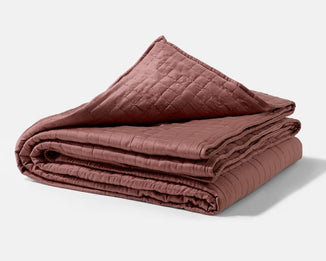
Jun 29, 2021
What Is the Best Sleeping Position for You?
When it’s time to settle down for sleep, you probably aren’t thinking about which sleep position is best for you. But if you care about your sleep quality and your health, you may want to rethink your posture at night. According to sleep experts, how we sleep at night affects everything from the spine to our gut — even the brain.
In this guide, we’ll take a deep dive into the three main sleeping positions — side, back and stomach — and share a few tips on how to get better sleep in any position (hint: a weighted blanket helps!).
Shop Our Weighted Blankets
Side Sleeping
If you sleep on your side, you’re in good company. According to one estimate, side sleepers account for nearly 75 percent of all sleepers. For the most part, sleeping on your side — and on your left side in particular — is a healthy way to snooze since it doesn’t put too much pressure on your organs. That said, let’s take a closer look at the pros and cons of grabbing shut-eye in this sleep position.

Pros of Side Sleeping
- Reduces snoring. If you snore regularly or have sleep apnea, sleeping on your side may be the best sleep position for you. Sleeping on your side reduces the compression on your airways, allowing you to breathe freely (and soundly!).
- Aids digestion. Sleeping on your side can also aid digestion, but only when you sleep on your left side. The reason? Lying on your left side makes it easier for food waste to transfer from the small intestine to the large intestine.
- Best for pregnancy. Expecting a baby? Some experts say that side sleeping is the best position for pregnant women because it allows maximum blood flow and nutrients to the placenta.
Cons of Side Sleeping
- May increase pressure on your heart. If you have heart problems, sleeping on your left side might not be the best position for you. Some sleep experts believe that sleeping on your left side can put pressure on your vena cava, which is the large vein that returns blood to the heart.
- Can exacerbate nighttime heartburn symptoms. Heartburn keeping you up at night? Avoid sleeping on your right side. Sleeping on the right side causes your stomach to hang above your esophagus, making it easier for stomach acid to travel to your throat and lungs.
- Can decrease blood circulation. The majority of side sleepers prefer to doze in the fetal position, in which their arms and legs are nestled close to their curled-up body. However, the downside of this position is that it can restrict blood flow.
Tip for Side Sleepers: Wake up feeling stiff and sore? Try putting a pillow in-between your knees while you sleep. This will help keep your spine, hips and pelvis in alignment.
Back Sleeping
If you count yourself part of the 10 percent of people who sleep on their back (aka, supine position), you may have hit the sleeping jackpot. Depending on which study you’re consulting, this position is widely considered to be the healthiest sleeping position because it’s the most beneficial to spine health. Read on for a few pros and cons of sleeping face up.

Pros of Back Sleeping
- Keeps your neck and spine in alignment. According to one study, back and side sleeping are both associated with fewer spinal problems compared to stomach sleeping. Sleeping on your back keeps your neck and spine in a neutral position, which decreases the likelihood of waking up feeling stiff and sore.
- Puts less pressure on internal organs. Hands down, back sleeping is the best position for your internal organs. Sleeping sunny side up helps prevent excess pressure on your organs while keeping them in proper alignment.
- Best sleep position for weighted blankets. Weighted blankets are a smart sleep investment no matter what your sleeping position, but they’re especially well-suited for back sleepers. When you sleep on your back, the weight of the blanket is evenly distributed across the body. (Tip: If you’re a side or stomach sleeper, consider choosing a less heavy blanket — like our best-selling Gravity Weighted Blanket in 15 lbs. – to avoid putting too much pressure on your muscles and joints.)
- Fewer headaches. If you occasionally wake up with terrible neck pain and a dull, throbbing headache, try sleeping on your back. Poor neck alignment can lead to cervicogenic headache, which is a secondary headache caused by pain in the neck.
- Prevents wrinkles. Some research has shown that pressing the face into a pillow during sleep can compress the skin, which can potentially cause sleep lines and wrinkles. Sleeping on your back helps keep your face out of your pillow, potentially reducing fine lines by eliminating compression.
Cons of Back Sleeping
- Aggravates GERD symptoms. Sleeping on your back can make it easier for acid to escape from your stomach and flow into the esophagus. If you’re a back sleeper, try propping up your torso with a wedge pillow.
- Worsens sleep apnea and snoring. Back sleeping is known for making sleep apnea symptoms and snoring worse. In this position, the tongue and soft tissue can easily fall back and obstruct the airway, causing a lack of airflow.
Tip for Back Sleepers: If you’re in the market for a new mattress, opt for a medium-firm or firm mattress. Softer mattresses are more likely to sink in, potentially knocking your spine and neck out of alignment.
Stomach Sleeping
Sleeping on your stomach (aka, the prone position) is the second most common sleep position, with 16 percent of the population preferring this position for slumber. Unfortunately, sleep experts generally don’t recommend this sleep position for most people since it can lead to a slew of neck and back problems.

Pros of Stomach Sleeping
- Diminishes sleep apnea symptoms. One of the few advantages to stomach sleeping is that it may improve snoring and other sleep apnea symptoms. Sleep apnea is often improved in the prone position because the tongue is less likely to block the airway.
Cons of Stomach Sleeping
- Leads to back and spine problems. When you sleep on your stomach, it’s virtually impossible to keep your spine in a neutral position. Over time, the stress on your spine can negatively affect other structures in your body.
- May cause nerve pain. If your spine becomes misaligned, you may experience nerve pain elsewhere in your body. This is because the spine is a highway for the nerves.
- Puts the neck at an awkward angle. One of the drawbacks to stomach sleeping is that you must turn your head to breathe, which puts the head and neck at an awkward angle. Although it may feel comfortable in the moment, keeping your neck in this position can make your neck feel stiff in the morning.
Tips for Stomach Sleepers: If you wake up with a stiff neck, try sleeping with a thin pillow made specifically for stomach sleepers. Additionally, using a mattress topper on top of a firm mattress may provide better support and comfort for stomach sleepers.
What Is the Best Sleeping Position for You?
So, what is the best sleeping position for your health and sleep quality? The answer may depend on factors such as your age, your medical history and whether or not you have any preexisting health conditions.
For instance, if you’re a forty-something with shoulder pain, side sleeping could aggravate the pain in your shoulder and rob you of a good night’s rest. Similarly, if you’re pregnant or have neck and back issues, stomach sleeping probably isn’t the best way for you to sleep.

Ultimately, the best sleep position is the one that makes you feel the most well-rested. If you have existing conditions or health concerns, it doesn’t hurt to talk with your doctor about which sleep position is right for you.
Don’t forget that there are also plenty of ways to modify your sleeping position to improve your health without compromising your sleep quality. Getting a healthier night’s rest could be as simple as placing a pillow under your knees or keeping your posture more relaxed.
Can I Change My Sleep Position?
Changing the sleep position you’ve held for most of your life isn’t easy. After all, we are creatures of habit and, according to science, it takes anywhere from 18 to 254 days to form a new habit. But if you’re determined to switch things up, it could pay dividends for your health later in life.
Here are a few tips to help you change your sleep position:
- Use the Tennis Ball Method – This method involves sewing a tennis ball onto your pajama shirt, which desensitizes rolling around due to the discomfort of the ball. You could also try this method using a fanny pack or a backpack.
- Try a Weighted Blanket – If you want to be a back sleeper, try a weighted blanket. Not only do weighted blankets help you sleep, but the extra weight of the blanket may help keep you on your back during the night. (Bonus tip: If you’re a hot sleeper, pick up a cooling weighted blanket to avoid overheating.)
- Figure Out Your Hang-Ups – To make the habit stick, you may need to do some digging to figure out why your body doesn’t like sleeping in the position you want. For example, maybe your mattress is too soft for back sleeping, which is why you prefer to roll onto your side.
Other Sleep Hygiene Tips
Getting proper shut-eye can be tricky no matter what your preferred sleeping position. Set yourself up for a good night’s sleep with these helpful tips:
- Set a regular bedtime. Getting on a sleep schedule can be hard, especially when you toss and turn all night. But sticking to a regular bedtime will help your body fall into a pattern, making it easier to fall asleep at night.
- Skip the caffeine. Caffeine blocks adenosine, a substance in your body that makes you feel sleepy. If you must have caffeine, cut yourself off at least six hours before bedtime. Additionally, watch out for sneaky sources of caffeine — like dark chocolate and decaf coffee (yes, there are still low amounts of caffeine in decaf drinks!).
- Exercise earlier in the day. Exercise has been proven to help people fall asleep faster and sleep more soundly at night. However, getting your sweat on too closely before your bedtime may backfire by keeping you awake at night. For optimal sleep, experts recommend avoiding vigorous activity for at least an hour before you hit the hay.
- Keep it dark and cool. People tend to sleep better when their bedroom is on the cooler side. If you’re having trouble sleeping, try turning the thermostat down by a few degrees to see if it helps.
- Ditch the electronics. Sorry, but your late-night Instagram-scrolling isn’t doing your sleep any favors. Electronic devices like phones and tablets emit blue light, which has been shown to reduce the production of melatonin (the sleep hormone). To get a full seven to eight hours of rest, ditch the screens and read a book instead.

The Takeaway
There’s no doubt about it — getting your body into the right sleep position could have a huge impact on your health and sleep quality. Each sleep position has its own unique pros and cons to consider, so choose the one that makes the most sense for you. After that, it’s all about creating the ideal sleep environment. Here at Gravity Blankets, we’re always happy to help!
Image Credits
ZoneCreative/Shutterstock.com
OneLineStock.com/Shutterstock.com
Ollie The Designer/Shutterstock.com
Your use of this website, its content, and any products obtained through this website is at your own risk. This website, its content, and any products obtained through this website are provided on an “as is” basis, without any warranties of any kind, either express or implied, including warranties of merchantability, infringement of intellectual property, or fitness for any particular purposes. No warranty or representation is made with respect to the completeness, reliability, quality, or accuracy of this website or its content. This website, its content, and any products obtained through this website do not constitute medical treatment and is not a substitute for a medical examination or diagnosis. If you are dealing with a health condition check with your health care provider before using. This website may contain affiliate links that allow us to earn a commission on purchases made through such links. We may accept forms of advertising or sponsorships in connection with this website. There might also be paid topic insertions. We may accept and keep free products, services, and other forms of compensation from others.












